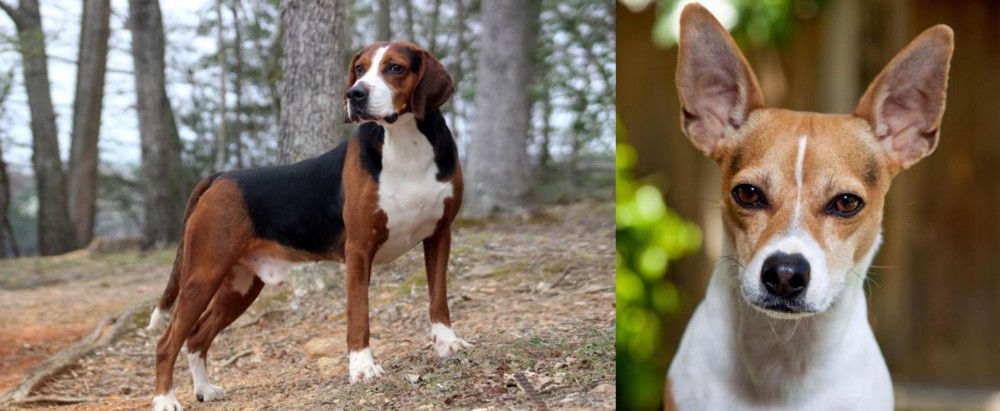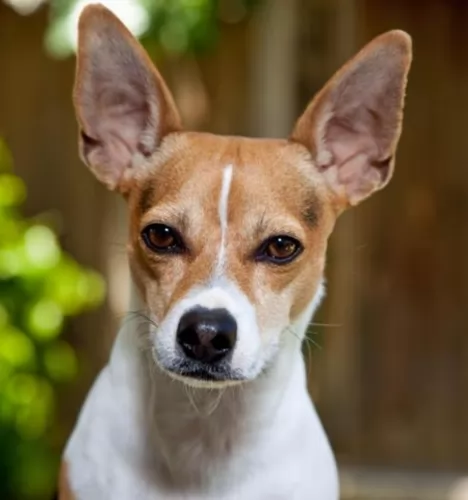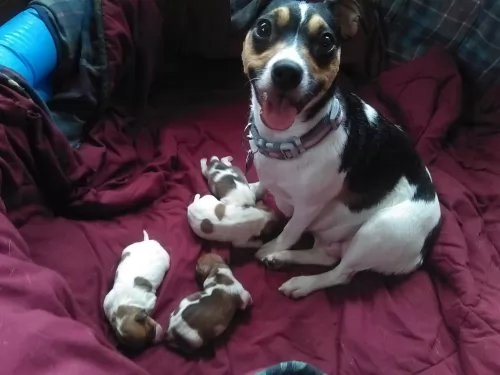 Petzlover
Petzlover Hamiltonstovare is originated from Sweden but Rat Terrier is originated from United States. Hamiltonstovare may grow 25 cm / 10 inches higher than Rat Terrier. Hamiltonstovare may weigh 23 kg / 51 pounds more than Rat Terrier. Hamiltonstovare may live 5 years less than Rat Terrier. Both Hamiltonstovare and Rat Terrier has almost same litter size. Both Hamiltonstovare and Rat Terrier requires Low Maintenance.
Hamiltonstovare is originated from Sweden but Rat Terrier is originated from United States. Hamiltonstovare may grow 25 cm / 10 inches higher than Rat Terrier. Hamiltonstovare may weigh 23 kg / 51 pounds more than Rat Terrier. Hamiltonstovare may live 5 years less than Rat Terrier. Both Hamiltonstovare and Rat Terrier has almost same litter size. Both Hamiltonstovare and Rat Terrier requires Low Maintenance.
 Bred as a hunting hound, the Hamiltonstovare hails from Sweden, being founded in the late 1800s. He was first exhibited in Sweden in 1886.
Bred as a hunting hound, the Hamiltonstovare hails from Sweden, being founded in the late 1800s. He was first exhibited in Sweden in 1886.
Known also as the Hamilton or the Swedish Foxhound, the dog was developed by Count Adolf Hamilton who was also the founder of the Swedish Kennel Club. The dog’s ancestry includes some German Hounds as well as Harriers and English Foxhounds, and this has ensured he has excellent hunting instincts.
This dog breed got the name Hamiltonstovare in 1921 as a tribute to the person who created the breed and also the founder of the Swedish Kennel Club, Count A.P. Hamilton. The Hamiltonstovare isn’t recognized by the AKC but is recognized by the FCI and is also a member of the Foundation Stock Service. He is recognized by the Kennel Club in the UK as a Hound.
 Known also as the American Rat Terrier or even as the Rattie, this American dog breed is a farm dog, common on family farms during the 1920's and 1930's.
Known also as the American Rat Terrier or even as the Rattie, this American dog breed is a farm dog, common on family farms during the 1920's and 1930's.
Miniatures or Standards, these dogs are also recognized by the American Kennel Clubs and thought of today as a multi-purpose companion dog.
He is an American dog breed, having come about from Fox Terriers, Old English White Terriers, Bull Terriers, Manchester Terriers and others. Whippets and Italian Greyhounds have also come into the mix to add speed as a characteristic.
The Rat Terrier started to decline in numbers, and by the 1950's the numbers of the dog were so low that breeders stepped in to restore numbers.
 The Hamilton Hound is a good looking, well proportioned dog with an attractive, 2-layered, shortish, smooth, tri-colored coat of tan, black and white.
The Hamilton Hound is a good looking, well proportioned dog with an attractive, 2-layered, shortish, smooth, tri-colored coat of tan, black and white.
These dogs stand at about 49-61cm in height and they weigh 23 – 27kg. The eyes are brown and the ears are floppy. He is a deep chested dog with a long tail which he carries straight or which is somewhat curved. He has a longish head with a skull that is slightly arched and broad.
Friendly, social and amicable, the even-tempered Hamiltonstovare is a dog that loves to be with his human family. When you look at him you look at him as a friend as he has a calm, intelligent expression about him.
He is a stubborn, non-aggressive dog that is intelligent and this makes it easy to have him trained and socialized to make him obedient and to follow some easy instructions.
He is a very active dog and will love an owner who leads an active, outdoor life. Most Hamiltons love swimming too and he will be thrilled if you plunge in with him on a hot day.
He has always been a hunting dog, and while they love spending time with their human family, he loves the thrill of the hunt. He is a playful dog too, loving to entertain and be entertained, and he gets on well with children.
 There are different sized Rat Terriers, but the mid-sized one stands roughly between 20 and 36cm in height and weighs between 3 and 4kg.
There are different sized Rat Terriers, but the mid-sized one stands roughly between 20 and 36cm in height and weighs between 3 and 4kg.
The single coat is short and smooth and comes in colors such as tan, grey, chocolate, black and in solid colors too such as white. They are mostly in tri-colors - white, tan, black. Ticking is also seen.
With his short coat he is seen as a low maintenance dog even though he is still a shedder, with heavier seasonal shedding.
The ears can sometimes be erect, otherwise they are half-erect, half floppy. The tail has always been traditionally docked, giving him a nice, distinctive look, but today the tail is often just left un-docked. It isn't unusual for a puppy to be born with a short or long tail.
Intelligent, wary, loyal, loving, playful but stubborn, your Rat Terrier is a little bit wary around strangers. Training and socialization can be good for this dog and help him t be obedient and well mannered in all situations. These dogs also want to please. He is an active dog too and makes a great playmate for children, getting on well with kids and other pets in the home.
 Hamiltonstovares make wonderful companions simply because they’re friendly dogs with stable personalities.
Hamiltonstovares make wonderful companions simply because they’re friendly dogs with stable personalities.
He is actually an ‘all-rounder’ dog – well proportioned and good-looking and with a solid personality to match.
He is lithe and muscled and as a multi-purpose dog, he has been used to follow scents and hunt down prey. These skills as well as his loyal characteristics have made him a versatile, sought after pet.
Another bonus when you own a dog like this is that he is also a low maintenance dog, shedding very little. He is intelligent too and easy to train, and all these qualities make him a wonderful pet to own.
 The Rat Terrier is such a clever, bright dog. These characteristics make him an excellent watchdog with strong jaws for his role of getting rid of rats on farms.
The Rat Terrier is such a clever, bright dog. These characteristics make him an excellent watchdog with strong jaws for his role of getting rid of rats on farms.
Even though he is a small dog, he isn’t particularly suited to life in the city on a small property as he has quite a shrill bark.
Because of him being small to medium in size, he is well suited to many homes, but you just have to watch out in the city if you live close to your neighbors as he is fairly noisy and active.
He would love a large property where he can just be himself. Provide him with the right home, and you’l have a friend for life.
 Every dog has different genetic make ups that affect them and they have different susceptibilities to illnesses. The average life expectancy of a Hamiltonstovare is between 10 and 13 years when he is looked after and well nourished with top quality food.
Every dog has different genetic make ups that affect them and they have different susceptibilities to illnesses. The average life expectancy of a Hamiltonstovare is between 10 and 13 years when he is looked after and well nourished with top quality food.
Some things to look out for are hip dysplasia, cancer, bloat and obesity.
Look out for obesity in your pet because just like with people, obesity leads to other diseases and complications in dogs such as diabetes, respiratory disorders, osteoarthritis and hypertension.
If your dog needs to lose weight, and you just don’t know how you’re going to deny him the treats he loves, speak to your vet who can even work out a weight management program for him.
Cancer is a formidable threat to all dog breeds. The most obvious sign that your dog could have cancer is abnormal swelling that gets larger under the skin. The idea is get get the lump removed and biopsied as soon as possible. Loss of appetite, weight loss, sores that don’t heal and bleeding or discharge are all signs of cancer.
 Rat Terriers are generally feisty, healthy dogs who, with good care, can live to the ripe old age of 16, 17 or 18 years of age.
Rat Terriers are generally feisty, healthy dogs who, with good care, can live to the ripe old age of 16, 17 or 18 years of age.
Just like with many other dogs, he can develop some of the more common dog illnesses there are. If you're opting for a puppy, find a good, reputable breeder.
It can be tricky trying to decide what kind of allergies are causing such problems with your pet. A skin allergy can cause a lot of itchiness and pain for your canine friend and he will bite and lick on the affected spots and make the situation worse. You will need to get him to the vet for some kind of treatment, as such an ailment can drive him mad.
This is a common problem in dogs, with the kneecap or patella being dislocated. It can cause a lot of pain and can be crippling for your dog.
 The Hamiltonstovare has a double coat but even so, he is a low maintenance breed that will simply require a brush twice a week to remove dead and loose hair.
The Hamiltonstovare has a double coat but even so, he is a low maintenance breed that will simply require a brush twice a week to remove dead and loose hair.
Because he has floppy ears, it is important to check his ears because too much wax and debris can lead to a painful infection.
This is a high energy dog who will need the right amount of exercise as well as mental stimulation to be at his best. A nice walk every day will be excellent for him as well as the usual ball games in the garden.
If you get your Hamilton puppy from a breeder, it would be wise to stick to the same food they were feeding your puppy with. Suddenly changing his good could cause digestive upsets.
Every Hamilton requires top quality food that meets all his nutritional requirements. If you give him commercially manufactured food, make sure to follow the instructions with regards to the amount of food you give him as he can put on too much weight.
These dogs are known to suffer with bloat, so rather give him smaller meals than one large meal a day. Your Hamilton should never be exercised immediately after eating a meal. Remember to always ensure a bowl of fresh, cool water is always available.
 Your Rat Terrier can easily reach 16, 17 or 18 years of age with good food. While you do get some excellent commercially manufactured dog foods, you want to add variety by including some nutritious home-made food too.
Your Rat Terrier can easily reach 16, 17 or 18 years of age with good food. While you do get some excellent commercially manufactured dog foods, you want to add variety by including some nutritious home-made food too.
Boiled chicken, brown rice or pasta and spinach, sweet potatoes and carrots are a healthy choice for your pet. Chop it up and add it into the dry kibble a couple of times a week.No complications - just plain and simple - the way dogs love it.
Some raw meat added in from time to time will help his skin and coat remain healthy. Never leave him without a constant source of fresh, cool water.
The Rat Terrier is an active dog. He just loves to dig too, so if you live close to a beach, he will love running and digging in the sand. If this isn’t possible, he will be happy to be taken on walks with you and maybe for a run in the park.
He loves all ball games and running after a frisbee, and he’s so clever, maybe you can even teach him to fetch the frisbee for you.
The Rat Terrier is a low-maintenance dog and only requires having his coat brushed twice a week.
Check inside his mouth for bad teeth. You can even brush his teeth with special canine toothpaste and brush to remove tartar buildup.
Keep his nails trimmed too if he doesn’t wear them down naturally so as to prevent them hooking on things and ripping into the flesh.
Check inside your dog’s ears too. If you’re not experienced with trimming dog nails or cleaning inside dog’s ears, your vet or professional groomer will do it for you.
During these grooming sessions with your Rat Terrier, check for fleas and ticks as well as for any sores or new lumps. Also, his eyes should be clear and bright with no discharge or redness.